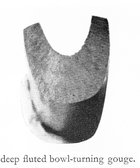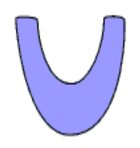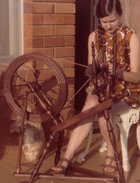I've adapted them to use as a double bevel scraper that is used flute down. The flute gives a slightly shear scraping action while being held flat on the tool rest.
I also date back to before gouges were machined from bar stock when gouges were hot forged from flat bar using presses or hand forging.
The ones off the press were all intended for use on spindle work. The traditional English spindle gouge is typically made from heavier plate stock than the thinner/shallower European style ones, called 'continental' gouges. The lighter section and narrow tanged continental gouges are not suited to roughing down spindle work for which the deep fluted roughing gouges were used. Most spindle roughing gouges are still made with that same pressed metal method.
The gouges intended for cross grain (typically bowl) work were hand forged from heavier stock and had deeper and narrower flutes than the spindle gouges. They also had much sturdier tangs than the spindle gouges. Here is a photo (on left) from Peter Child's 1970s book showing what was called a deep fluted bowl gouge and below it the profile as redrawn by Roy Child, Peter's son...
Of course, that didn't stop turners swapping the intended uses of these gouges around!




